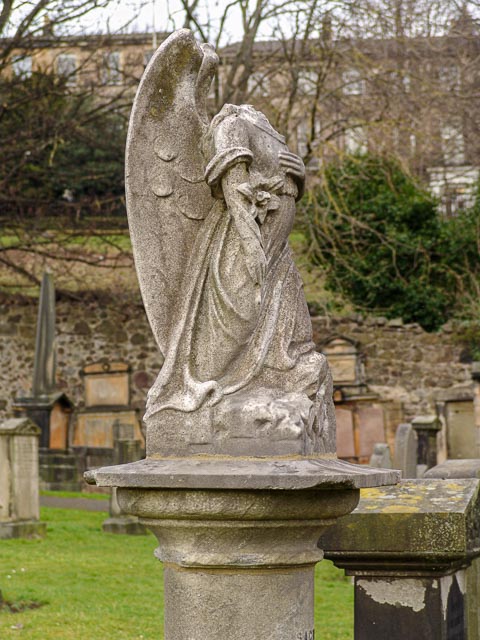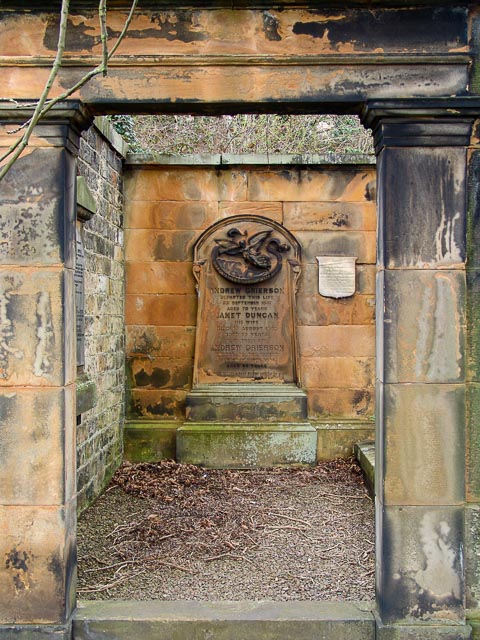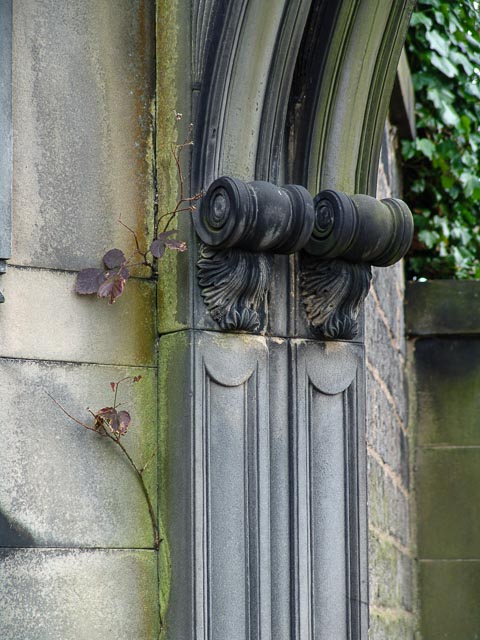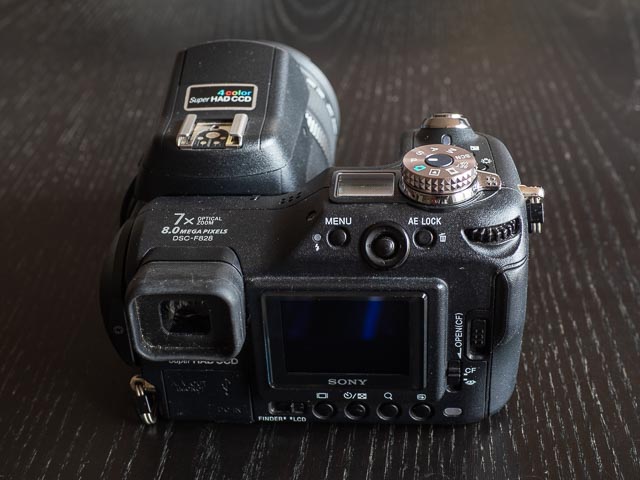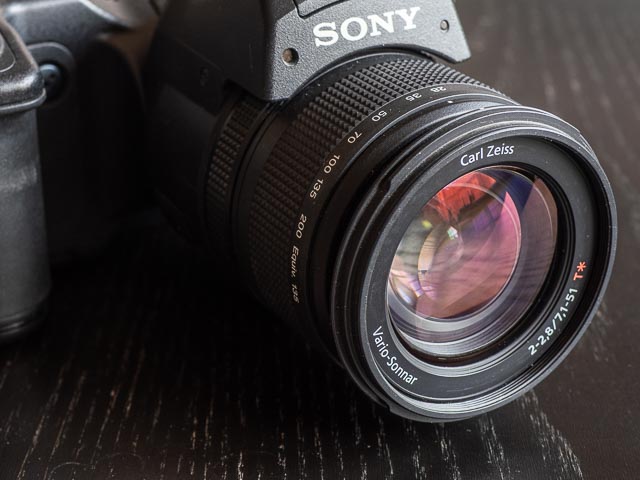Sony Cyber-shot DSC-F828

Introduction
| Launch date | August 2003 |
|---|---|
| Camera type | Advanced digicam with electronic eye-level viewfinder ("bridge-camera" style) |
| Camera size | 906 grams 134 x 91 x 156 mm (inc. battery) |
| Sensor type | Super HAD CCD |
| Sensor size | 2/3" (8.8 x 6.6 mm) |
| Resolution | 3264 x 2448 (8 megapixels) |
| Lens | Carl Zeiss Vario-Sonnar 7.1-51mm f/2-2.8 (35mm equiv. 28 - 200mm, 7x zoom ratio) |
If you just want to see some photographs, skip straight to the results section, or read about infrared photography with the Sony Cyber-shot DSC-F828.
35mm film cameras all have to accept the same 135 film cassette, and although there is an incredible variety of 35mm camera designs, this does place certain contraints on the camera designer that they can't entirely escape from. When digital cameras removed that constraint, camera designers, particularly in the first 10-15 years of the digital photography era, really went to town exploring the possibilites this could provide. Of course not all these experiments were successful, either commercially or practically, but it was certainly fun watching camera designers go wild!
One of the ideas that was popular right from the earliest days of digital cameras, was splitting the lens and sensor into one module, and the controls, battery, electronic, viewfinder, monitor, etc. into a second module, which were then joined with some kind of twisting mechanism. One example of 'split body' camera design was one of the earliest commercially successful digital cameras, the Casio QV-10 of 1995. And perhaps the best known example is the Nikon Coolpix 900 series of cameras (including the Nikon Coolpix 950 which you can read about on this site.) Sony had several variations on this theme which they grouped together in the Sony Cyber-shot F series of cameras. Perhaps the most unique of the Sony split-body variations was the F triple digit series of cameras: the Sony DSC-F505 of 1999, Sony DSC-F505V of 2000, Sony DSC-F707 of 2001, Sony DSC-F717 of 2002, and culminating in the subject of this page, the Sony Cyber-shot DSC-F828 of 2003. (Digital camera product cycles where very rapid at this time… annual product launches where common!) These cameras all combined a split body with a high powered zoom lens for a unique degree of flexibility in framing and composing images from a variety of angles.
The Sony Cyber-shot DSC-F828 in use
The F828 took Sony's tripple digital F series into a whole new league:
- To begin with the light weight silver aluminimum body of the earlier models was replaced with a black metal body with a professional looking black stippled finished.
- The body featured a much larger DSLR style grip and a very impressive selection of external controls.
- The lens went from a 5x zoom with a widest angle of view of 38mm (35mm equiv.) and en electronic zoom controlled to a very impressive Carl Zeiss T* branded 28-200mm lens with a mechanical zoom control.
- And Sony also pushed the boat out with the sensor, going with a larger than average 2/3" (8.8x6.6mm) 'Super HAD CCD' four colour design.
Most CCD sensor use 3 colours of pixels (RGB or red, green and blue), but the sensor in the F828 is an RGBE four colour design. If you're wondering what colour the letter E might stands for, it's emerald (although it was in fact a colour any normal person would call cyan!).
The end result was a camera that does indeed handle beautifully, with an excellent feel in the hand from that large and confortable grip and controls that on the whole fall naturally to hand. And the split body design that really does help enormously with taking photographs from either high over-head angles of low down and close to the ground.
But although the ergonomics are great by the standard of the day, there are still a few things that might trip up many users of modern digital cameras. Like many cameras from 20+ years ago the F828 uses a 'modal' form of operation. That is to say, the mode dail features separate modes from shooting, playback and set-up modes. So when you hit the menu button in the course of taking photographs you will hunt in vain, for example, for an option to format the memory card. Instead you have to move the mode to "set-up" and then hit the menu button. This means that while most modern digital cameras will instantly switch back to shooting mode, regardless of what you're doing, when you touch the shutter button, on the F828 you'll stab uselessly at the shutter button until you remember to turn the mode dial back to one of the shooting modes. But that's just how the vast majority of cameras from this era operated… you get used to it.
And the electronic eye-level viewfinder (and rear-of-camera monitor too) are very low resolution and pixelated by modern standards. I remember at the time thinking I would never use a camera with an electronic viewfinder, preferring instead to stick with a real DSLR with an optical viewfinder. This camera reminds me why I used to think that!
But despite these obvious deficiencies that plagued all cameras of a similar vintage, the F828 is a surprising pleasure to use. It shows that even early on in their journey to beoming a photogray heavy-weight, Sony could compete with the biggest names in the photography industry when it comes to ergonomics.
One final thought, let's not be coy about the size of this camera… it's humungous! It takes up more space in a camera bag than many a DSLR and it weighs in at over 900 grams. It's also damned ugly  . It looks like it was designed by committee and stiched together out of a random selection of bits from other cameras. But if it works, it works, huh? And I suppose you can say it has character!
. It looks like it was designed by committee and stiched together out of a random selection of bits from other cameras. But if it works, it works, huh? And I suppose you can say it has character!
Sony Cyber-shot DSC-F828 results
Over all the results from this camera are very impressive, though I'm not sure if I can really see any evidence that the four colour RGBE sensor is really any better than a standard three colour RGB alternative. The main problem are the typical problems of any camera from this period: mainly clearly visible purple fringing on high contrast transitions, and a lack of dynamic range. But when used within it's limitations the F828 is still a serious photographic tool even in 2025. But you can make you're own mind up:

Typical of most camera from the early to mid 2000s, the F828 can display some pretty bad chromatic aberrations in the form of purple fringing at the borders between dark and light elements. It was really visible around the branches of this tree where they lay against the sky. Here I've zoomed in on the tree so you can see it clearly…

…but fortunately it's fairly easy to clean up in Lightroom. Here's the whole image with the chromatic aberrations cleaned up using Lightroom's built in tools.

Another shot showing the limitations of early 2000s sensor technology. The daffodils in the foreground have come out rather nicely, but there just isn't the necessary dynamic range to render the sky in an attractive way.

When you have flat pale grey skies it's better to just leave the sky out of the composition! Of note here is the very nice bokeh this camera can generate, despite the smallish sensor, at least when you're fairly close to the subject.








